 |
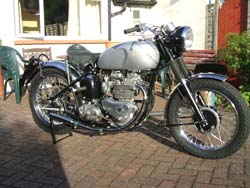 The bike you see before you was built by me from bits & bobs I had in the shed. “Who has a GP engine lying around in their shed?” I hear you cry, well it’s a long story, but the engine found it's way into my care about 15 years ago. A friend had it and I wanted it so he leant it to me. Simple. Then it sat on the shelf while various projects came and went. I always had a road bike in mind and a loose idea of what I wanted, but until a few years ago everything else took precedence. By this time I'd acquired a front frame loop from a 1951 T100, a rear frame from a TRW, a pair of hubs and forks and a fuel tank from a swing arm 650 twin, together with lots of other assorted bits and pieces. The realisation dawned that with a bit of ingenuity and some time on my lathe I had the basis of a bike. I swapped a Norton "lay down" gearbox for a rigid Triumph one and a set of primary cases. I saw a pair of cases go on Ebay recently for £250 so I think the deal was a good one. The overriding principal of the build was to keep costs to a minimum and to farm out as little a possible. The engine's quite interesting in that it was produced during the war as an auxiliary generator on heavy bombers. The unusual straight inlet & exhaust ports were a space saving idea and it was fitted with a tin cowl with a crank driven fan for cooling. I've tried to obtain a picture of the device in it's wartime guise but as yet no joy. The bike you see before you was built by me from bits & bobs I had in the shed. “Who has a GP engine lying around in their shed?” I hear you cry, well it’s a long story, but the engine found it's way into my care about 15 years ago. A friend had it and I wanted it so he leant it to me. Simple. Then it sat on the shelf while various projects came and went. I always had a road bike in mind and a loose idea of what I wanted, but until a few years ago everything else took precedence. By this time I'd acquired a front frame loop from a 1951 T100, a rear frame from a TRW, a pair of hubs and forks and a fuel tank from a swing arm 650 twin, together with lots of other assorted bits and pieces. The realisation dawned that with a bit of ingenuity and some time on my lathe I had the basis of a bike. I swapped a Norton "lay down" gearbox for a rigid Triumph one and a set of primary cases. I saw a pair of cases go on Ebay recently for £250 so I think the deal was a good one. The overriding principal of the build was to keep costs to a minimum and to farm out as little a possible. The engine's quite interesting in that it was produced during the war as an auxiliary generator on heavy bombers. The unusual straight inlet & exhaust ports were a space saving idea and it was fitted with a tin cowl with a crank driven fan for cooling. I've tried to obtain a picture of the device in it's wartime guise but as yet no joy. |
||
It was found after the war that the parallel, (cross flow), ports produced more power than the usual splayed port Triumphs. So before long a plethora of war surplus generators lost their heads and barrels to road & race specials. Triumph weren't usually drawn into racing as the management saw it as a waste of money, but were persuaded to produce a works race version which gained some notable, albeit limited, success and was christened the Grand Prix. The head and barrels on mine are genuine war surplus items. The head is unusual in that the combustion chamber has an iron skull, around which the alloy is cast. It's also unusual because the plugs are short reach. Alloy headed British bikes almost always use long reach plugs, but this is explained by the fact that the iron headed Triumphs of the day used short reach plugs and it appears that they were trying to keep to available stock items for the war effort. The bottom end is standard T100 of 1947 with 3134 cams, R followers and a later alternator crank. No particular reason for the crank, it was what I had. |
||
The build began by fitting all of the parts I had prior to refurbishing to prove the idea worked. I then made or adapted several parts, such as a speedo drive on the rear hub, modified metric taper roller bearings for the steering head and an assortment of spacers and special bolts. The rocker feed and drain banjo bolts were a Whitworth thread and proved difficult to find so I adapted some 12mm stainless button headed bolts by machining the heads and correcting the threads to end up with items which, I think, look really good and encourage an oil tight joint. I also fitted 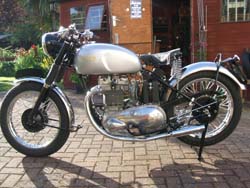 an oil filter housing, (the shiny thing under the seat), and this is the thing I get asked about most. Questions like “what’s that shiny thing under the seat?” I persuaded one chap that it was a nitrous bottle! an oil filter housing, (the shiny thing under the seat), and this is the thing I get asked about most. Questions like “what’s that shiny thing under the seat?” I persuaded one chap that it was a nitrous bottle!When all was assembled and appeared O.K, the frame and ancillaries went for powder coat, the engine & gearbox was stripped and rebuilt and the whole shooting match was assembled in about two weeks. The end result is a total "bitsa", but I think it all hangs together just right. It goes like stink and is a real handful when the roads get bumpy. This means you can have as much excitement piloting it at 50mph as you would at 100mph on a modern Jap bike. I like it. What do you think? |
||
-Andy Forward |
||
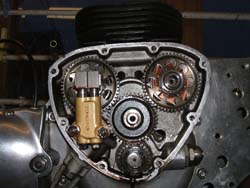 |
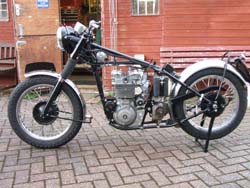 |
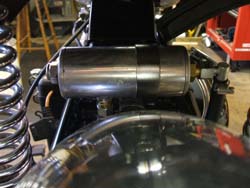 |
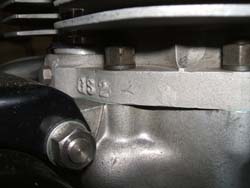 |
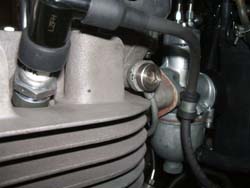 |
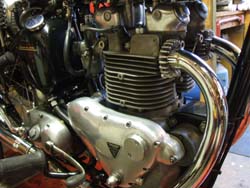 |